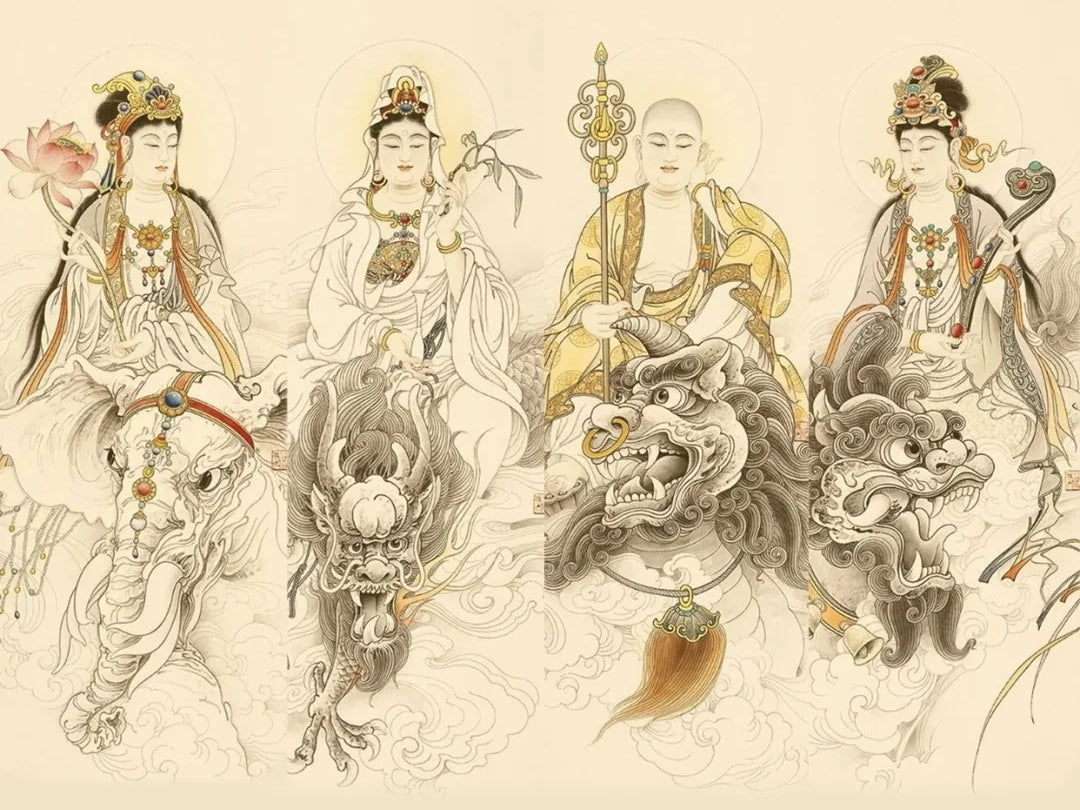In Buddhist scriptures, Ksitigarbha Bodhisattva is celebrated for his profound vow: “Until hell is empty, I shall not attain Buddhahood.” This simple yet powerful eight-character mantra conceals a deeply moving story that has inspired generations of practitioners. At QiLing Aura, our collection of Tibetan Buddha jewelry—including elegant Buddha pendants and spiritual jewelry—draws upon these timeless teachings to help you cultivate compassion, diligence, and inner strength.

The Origin of Ksitigarbha Bodhisattva
Long ago, in a land of ancient Brahmins on South Jambudvipa, there lived a noble young woman named Guangmu. Born into a family of high status, Guangmu was renowned for her virtuous character and gentle nature. Despite her noble birth, her life was marked by sorrow. Her mother, who followed misguided beliefs and disrespected the Triple Gem, repeatedly ignored Guangmu’s heartfelt advice to embrace the Buddha’s teachings. When her mother suddenly passed away, Guangmu was overwhelmed with grief—not only for the loss of a loved one but also out of fear that her mother’s neglect of the Dharma would condemn her to endless suffering in the lower realms.

A Vow Born of Desperation and Love
Distraught and desperate for answers, Guangmu journeyed to an ancient temple where a venerable Buddha statue stood in solemn splendor. Overcome with sorrow, she knelt before the statue and wept, “O World-Honored One, please tell me—where is my mother now? Is she at peace?” In that moment, a celestial voice resonated through the silence, saying, “Guangmu, arise. I know the fate of your mother. If you can offer devout support to the Buddha for the next seven days, I will reveal her destiny.”
Joyfully accepting this divine challenge, Guangmu devoted herself to the task. She cleansed herself with ritual baths, changed into pure garments, and set up a humble offering of incense, fresh flowers, and simple fruits before the Buddha. For seven days, she chanted scriptures and prayed with unwavering devotion.
At the end of this period, while in deep meditation, Guangmu experienced a visionary encounter with a majestic Buddha. The Buddha explained, “Guangmu, your mother, because of her lifetimes of neglecting the Dharma and accumulating harmful karma, has descended into the lowest hell, where she suffers indescribable pain.” Heartbroken, Guangmu cried out, “World-Honored One, how can I save my suffering mother?”
In that moment of profound despair and resolve, Guangmu made a vow that would echo through the ages: “I vow, for all future eons, to save every being in hell from suffering. As long as one soul remains in torment, I shall never attain Buddhahood.” The earth trembled, and the heavens resounded with the sound of sacred Brahma chants as flowers rained down from the sky. Moved by her immense vow, the Buddha declared, “Your determination has touched all directions of the universe. From this day forth, you shall be known as Ksitigarbha Bodhisattva.”

Ksitigarbha’s Mission: Compassion in Action
Ksitigarbha Bodhisattva’s story is one of profound filial piety and unyielding compassion. Despite the immense personal sacrifice required, she committed herself to the salvation of all beings who suffer in hell. Her vow became a beacon of hope—a promise that no matter how deep the darkness, even a single act of kindness can lead to liberation.
According to Buddhist texts, Ksitigarbha not only saves beings from the torments of hell but also teaches them the law of cause and effect. She emphasizes that all suffering stems from negative karma, and by turning away from harmful actions and cultivating virtue, one can escape the cycle of rebirth. Her teachings inspire countless practitioners to plant the seeds of goodness, with the belief that even a single good deed can lead to spiritual awakening.
A famous element of her iconography is the tin staff she carries. Tradition holds that whenever Ksitigarbha reaches the gates of hell, the sound of her staff cracking open the door signifies the liberation of those tormented souls, offering them a path to redemption and peace.
Incorporating Ksitigarbha’s Wisdom into Modern Spiritual Jewelry
At QiLing Aura, we believe that ancient legends can powerfully inspire modern living. Our range of Tibetan Buddha jewelry and Buddha pendants captures the spirit of Ksitigarbha Bodhisattva’s immense vow and selfless compassion. Here’s how you can integrate this timeless wisdom into your daily life:
-
Wear Your Guardian Pendant:
Choose a Buddha pendant inspired by Ksitigarbha to serve as a personal talisman. This piece will remind you of the transformative power of compassion and the importance of selfless action. -
Enhance Your Meditation:
Incorporate your pendant into your meditation practice. Let the image of Ksitigarbha guide you to reflect on the law of cause and effect and inspire you to cultivate virtue and kindness. -
Connect with Cultural Heritage:
Our handcrafted jewelry combines traditional thangka artistry with modern design, making each piece a bridge between ancient Buddhist wisdom and contemporary aesthetics. Whether worn at work, during meditation, or on special occasions, these items provide both beauty and spiritual protection.
Conclusion
The moving story of Ksitigarbha Bodhisattva—born as Guangmu, who vowed never to attain Buddhahood until every suffering being was freed—serves as a profound reminder of the transformative power of compassion and selfless dedication. Her legacy inspires not only those on the path to enlightenment but also influences the art of Tibetan Buddha jewelry. By wearing a Ksitigarbha-inspired Buddha pendant or another piece of spiritual jewelry, you carry a timeless message of hope, protection, and the pursuit of inner peace.
Embrace the wisdom and compassion of Ksitigarbha Bodhisattva, and let her inspiring story guide you on your journey toward a more enlightened life.




